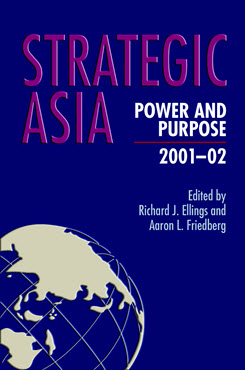South Asia (Strategic Asia 2001-02)
This chapter focuses on appraising the strategic environment in South Asia with an emphasis on understanding the geopolitical trajectories of the region’s more important states. Accordingly, it will concentrate mainly on India and to a lesser degree Pakistan, while referring as necessary to the security postures of other South Asian states and to the influence of other key external actors.
The South Asian region is defined as the Indian subcontinent, that is, the geographic landmass bounded principally by the Hindukush, Karakoram, and Great Himalayan ranges in the north and the Indian Ocean in the south. By all indices of national power, such as physical size, population, economic strength, and military capability, the most prominent state in the region is India. It is followed, in terms of such indices, by Pakistan, Bangladesh, Sri Lanka, Nepal, and Bhutan. Adjoining states with political relations with the region—Afghanistan, Burma, and China—lie outside the geophysical boundaries of the subcontinent, although China, with its large concentration of economic and military capabilities, not only possesses a “virtual” presence in South Asian geopolitics that is hard to ignore but also represents a fulcrum of potential rivalry with India that could have significant consequences for Asian security over the long term. This chapter focuses on appraising the strategic environment in South Asia with an emphasis on understanding the geopolitical trajectories of the region’s more important states. Accordingly, it will concentrate mainly on India and to a lesser degree Pakistan, while referring as necessary to the security postures of other South Asian states and to the influence of other key external actors.
The chapter is divided into three sections: the first describes the geopolitical trajectories of the principal South Asian states and in particular how these trajectories have changed with the end of the Cold War. The second section assesses the possibility of an emerging geopolitical transformation within South Asia—that is, the likelihood that India will emerge over the course of the next decade as the clearly preponderant power on the subcontinent—and the implications of this transition for Asian geopolitics at large. The third discusses the prospects of India becoming a consequential actor on the wider Asian stage. The fourth section discusses the implications for the United States and surveys the principal strategic challenges facing the United States in the region.
Strategic Asia
The Strategic Asia annual edited volume incorporates assessments of economic, political, and military trends and focuses on the strategies that drive policy in the region. Learn more about Strategic Asia.


